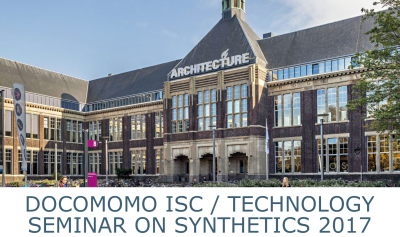Plastics in Modern Movement Buildings. Conservation and (Re-)design of Synthetic Building Components
DOCOMOMO ISC/Technology Seminar | 23-24 October 2017 | TUDelft, Netherlands

The International Exhibition in 1862 marked the start of the modern plastics industry with the first displays of semi-synthetic plastics to the public. Apart from polymers based on carbon, which is mainly derived from petroleum products, plastics contain additives which provide a wide variety of properties and appearances. The first fully synthetic materials were developed in the early Twentieth Century and by the late 1920s wall finishes, panelling and laminates were introduced as building materials, though mainly for interior use. The use of (semi-)synthetic materials as structural building materials dates back to the 1950s, introducing flat wall panels and façade claddings, shells and other 3-dimensionally formed plates. Since the 1960s, synthetics were increasingly recognised as essentially modern building materials due to their suitability to create ‘plastic’ forms as well as their functional characteristics, i.e. in terms of hygiene, resistance to weathering and easy maintenance. The structural use of synthetic building components became wide-spread and new types of synthetic materials and composites, such as PVC, polyesters and fibre reinforced plastics (FRP, GRP), were introduced. Experimental houses were shown at international exhibitions to promote the use of synthetics for mass-produced building parts in standardised housing. As a result hundreds of buildings featuring structural and architectural synthetic components are today part of the post-war architectural heritage.
However, while the degradation of synthetic building components – and claddings in particular – is an increasing challenge in heritage buildings, research on the degradation of synthetic architectural building components and the development of appropriate strategies for their architectural conservation, restoration and replacement is still in its infancy. In 1994, Anthony Walker published his seminal paper ‘Plastics: The Building Blocks of the Twentieth Century’ in Construction History, exploring the development and history of synthetic building materials. The key publication ‘Twentieth Century Building Materials’ of 1995 features various chapters on (semi-)synthetics identifying issues of degradation, weathering and repair of laminates, polyesters, fibre reinforced plastics and vinyl but rightfully concludes that further study on conservation methods is generally needed.
Through its International Specialist Committee on Technology (ISC/T), the International Working party for the Documentation and Conservation of buildings, sites and neighbourhoods of the Modern Movement DOCOMOMO therefore takes the initiative to bring together knowledge and expertise in a combined effort to address the conservation and repair of synthetic building components, interiors, finishings and objects in modern architectural heritage.
A one-day international seminar focussing on the exterior applications of synthetic building materials will take place on Monday October 23rd, 2017, at the Faculty of Architecture and the Built Environment at TU Delft, the Netherlands. Entitled ‘Plastics in Modern Movement Buildings. Conservation and (Re-)design of Synthetic Building Components’ the programme will feature a.o. material scientists, art conservators, architectural historians, architectural heritage specialists, designers, consultants and practitioners. An excursion to various relevant sites is scheduled for Tuesday October 24th, 2017.
Date: Monday October 23rd & Tuesday October 24th
Location: TU Delft, Faculty of Architecture and the Built Environment, Berlagezaal
Registration: regular: € 50,-, students: € 15,-, https://www.cvent.com/d/b5qtp3
Contact: plastics-seminar2017@tudelft.nl
A second seminar focussing on interior applications of synthetic materials in Twentieth Century historic buildings will be organised at the University of Antwerp, Belgium, on March 5th, 2018, entitled ‘Plastics in Modern Movement Interiors. Conservation and (Re- )design of Synthetic Finishes, Furniture and Products’.



